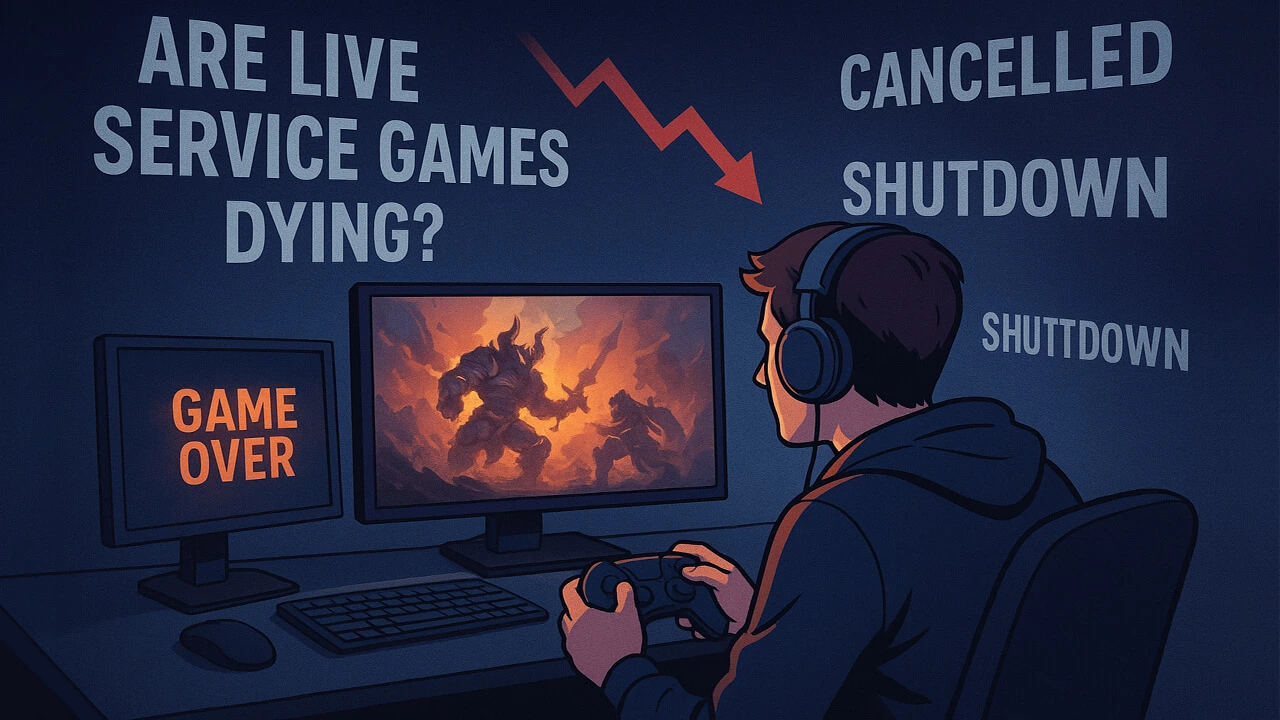
Live service games are never going to disappear. It’s a huge $12.3bn market that, for many Gen Z gamers, is all they’ve ever known. League of Legends, WoW, Dota 2, and Call of Duty: Warzone are just many of the names that illustrate the sheer depth and quality that many of these games have.
The model itself has also been massively successful for the lucky developers and publishers who’ve been able to pull it off, and the overall demand for these games is clearly still there.
If you look at the upcoming Honor of Kings: World, that’s a live service hit just waiting to happen. But the pendulum could be swinging back towards the classic video game model, if the latest trends are anything to go off.
Live Service Games Might Be Losing Their Hold On The Industry
Ever since Fortnite exploded onto the scene back in 2017, live service games have dominated gaming. In 2024 alone, 58% of PC video game revenue came from microtransactions, and it’s a similar story across both console and mobile as well.
It’s been, for lack of a better word, a live service game boom, with the movement going on a hellacious run-up until the mid-2020s.
But, like most things in gaming, there’s a chink in the armour, and it appears as though live service games are finally starting to slow down.
You could say it’s fatigue, with some players growing tired of the freemium model while longing for the “good old days” when blockbuster AAA games were being released on the PlayStation 3 and Xbox 360 every other week.
Countless live service games have started being cancelled, many leading games like Fortnite are reporting all-time player lows, and even some casual gamers are ditching video games altogether to play inside social casinos, popularized by the likes of Adin Ross and xQc, where games like the surprising hit Fish Tables have gotten players hooked.
Sony Has So Far Cancelled 8 Out Of 12 Live Service Games Promised By 2025!
Sony has built an incredible legacy with the PlayStation and practically blew Microsoft out of the water with its run throughout the 2010s into the current decade.
Yet, for some reason, Sony decided it wanted to focus its attention on the live service market, promising a boatload of 12 live service games to be released by 2025.
Here we are today, and only one of these games, Helldivers 2, has had a successful launch.
The rest? Well, as the Sony CFO hilariously admitted, it is “not entirely going smoothly.”
Seven of the proposed live service games have been outright cancelled, while three of them are allegedly still in development, although what will come of them remains to be seen (one of these games includes the questionable Marathon).
And when a big name like Sony is cancelling live service games left, right, and centre, you have to consider the fact that live service games might be in a little bit of trouble.
Shutdowns And Player Drop-offs
As a developer or publisher in the gaming industry, there was a time not that long ago when, if you wanted to make the big bucks, you’d release a free-to-play live service game.
The problem, though, is that the market is now beyond saturated, and you’re not guaranteed to get a return on your investment.
Sony appears to have missed the boat on this one, but it’s not just them who are struggling with live service problems.
Rumbleverse, Knockout City, and Omega Strikers were all incredibly original ideas that tried to break away from the typical live service game mold, yet they were all promptly discontinued by developers soon after launching.
And on top of this, there’s a mountain of other live service games that have struggled.
The First Descendant lost over 95% of its Steam player base in just half a year.
Helldivers 2 lost around half of its users in two months. Warner Bros Games’ live service crossover fighting game, MultiVersus, even got shut down in the summer after a troubled run.
Then, this month, there will be the shutdown of live service mech shooter Steel Hunters, announced only three months after it began early access. A bunch of mixed reviews and an all-time player peak of just 4,479 meant they had no option but to pull the plug, and it’s becoming something of a common theme.
All of these shutdowns received backlash at the time from passionate players, but it ultimately meant nothing.
If a live service game gets shut down, it’s usually because of poor gameplay performance, low player numbers, or a lack of funding. And, unfortunately, this has proven to be the case with countless live service games over recent years.
Even A Marvel IP Doesn’t Guarantee Success Anymore, With Marvel Rivals Flopping!
You’d think any live service game with Marvel’s IP attached to it would be a guaranteed success, right?
Marvel Rivals has been troubled from the get-go, with the entire development team getting laid off. And even though the game remains in the top 10 on Steam, its total player count has plummeted from 644,000 in January to well below 100,000 in September, and there’s no telling how low it might become at the end of the year.
Love or hate Marvel, this is a serious warning message for the wider industry, as launching a successful live service game now clearly requires a lot more than just a free-to-play label.
An Overreliance On Huge Player Bases And Microtransactions!
From the outside looking in, it’s obvious what’s causing the problem for live service games.
There is, simply put, too much of a reliance on huge player bases and microtransactions.
Not to mention, the market is beyond oversaturated. Remember, most live service games launch for free. That means you need to rack up some serious player numbers to recoup your investment. Not to mention, you also need that initial burst of players to stick around to gain revenue from microtransactions. Otherwise, you’re screwed.
It’s a seriously risky business model for developers and publishers. Now, even if your game is attached to a legendary IP, even that doesn’t guarantee you’ll make it to the promised land, which is, seemingly, why there’s now a growing number of developers backing off from the live service game trend to try and figure out what’s going on.
Battle Pass And Loot Box Fatigue
You also have to look at it from the player’s perspective. Live service games are heavy on battle passes and loot boxes because they have to be.
If they don’t push these things, they can’t make any money back. This is fair enough, but a lot of players are starting to experience battle pass and loot box fatigue after close to 10 years of being bombarded with them.
A few years ago, signs of fatigue were already starting to show when a PocketGamer.biz survey revealed that 42% of PC players and 35% of console players disliked loot boxes (today, those figures would likely be even higher).
And it’s not even that microtransactions and loot boxes themselves are bad components of gaming.
In fact, it’s quite the opposite, as they certainly bring something fresh to the experience. The problem comes from greed, and it seems to have taken over live service games, largely starting the current downward trend we’re starting to see.
Developers Are Worried
With all this going on, even the developers themselves are starting to panic a little. A survey was done last year that found 70% of developers are concerned about the sustainability of current live service games, expressing concern at how difficult it is to keep players hooked and prevent them from losing interest when there are so many free-to-play live service games to pick from.
These concerns are understandable post-2020 now that the market has been flooded with live service offerings. And the fact that a big chunk of these games are struggling to get off the ground, even when they’re attached to legendary IPs, is something you can’t ignore as a developer.
The Shift Back To A “Premium” Model from The Old Days.
With the live service game sector on wobbly legs at the moment, don’t be surprised to see a shift back to the all-too-familiar premium gaming model from decades gone by.
The problem with live service games at the moment is that they’re incredibly difficult for developers and studios to break into. The likes of Valorant, League of Legends, Roblox, and Fortnite have such a strong grip on existing players that it makes the live service market insanely risky, especially if your development costs are sky-high and there’s no guarantee of a return.
This is why the next few years are likely going to see the ‘classic’ video game model comeback, even if it’s on a much smaller scale than before. At least by selling games up front, publishers give themselves a better shot at recouping costs without gambling everything on the oversaturated live service market.
They’ll have to be careful with their pricing, though, because gamers have spent the past half-decade complaining nonstop about the rise of video game prices.
With $60 to $70 price tags now normalised, it’s led to a 25% drop off in video game spending among 18 to 24 year olds, so even the tried-and-tested model of the past isn’t a guaranteed success either. From the perspective of developers and publishers, it’s a tricky spot to be in.
Plenty Of Live Service Games In The Pipeline Show Things Are Far From Over!
Let’s not forget that there are also plenty of live service games coming up next year. On top of this, classic games like Valorant, League of Legends, and many of the games in the live service market are, for all intents and purposes, still booming.
The live service market is showing signs of fatigue, as a growing number of players are becoming tired of endless microtransactions, “gotcha” mechanics, limited-time battle royales, and other engagement mechanics that have ruled the industry since Fortnite changed it forever back in 2017, but it doesn’t mean it’s over.
Live service games absolutely peaked in the late 2010's and early 2020s, that’s undeniable. During those times, you could practically release any live service game you wanted and make millions off the back of it, so the gold rush has run dry.
However, live service games are still in demand, and plenty more of them will keep being released. The sad news for die-hard fans of this market, though, is that they’re almost certainly going to be scaled back over the coming years, as developers and publishers give the market space to breathe and assess the constantly evolving needs of the modern gamer.
Blog / Wiki / BrightyGames
Date Added: Monday, 6 October 2025 (GMT-5) Time in Chicago, 11:13 IL, USA
Related Articles: Best Multiplayer Games Of This Year: A Comprehensive Guide
Best Competitive Multiplayer Games You Will Enjoy
Latest Horse Racing Games: New Gen Equestrian Titles
Best Tips For Playing Offroad Outlaws Unblocked




